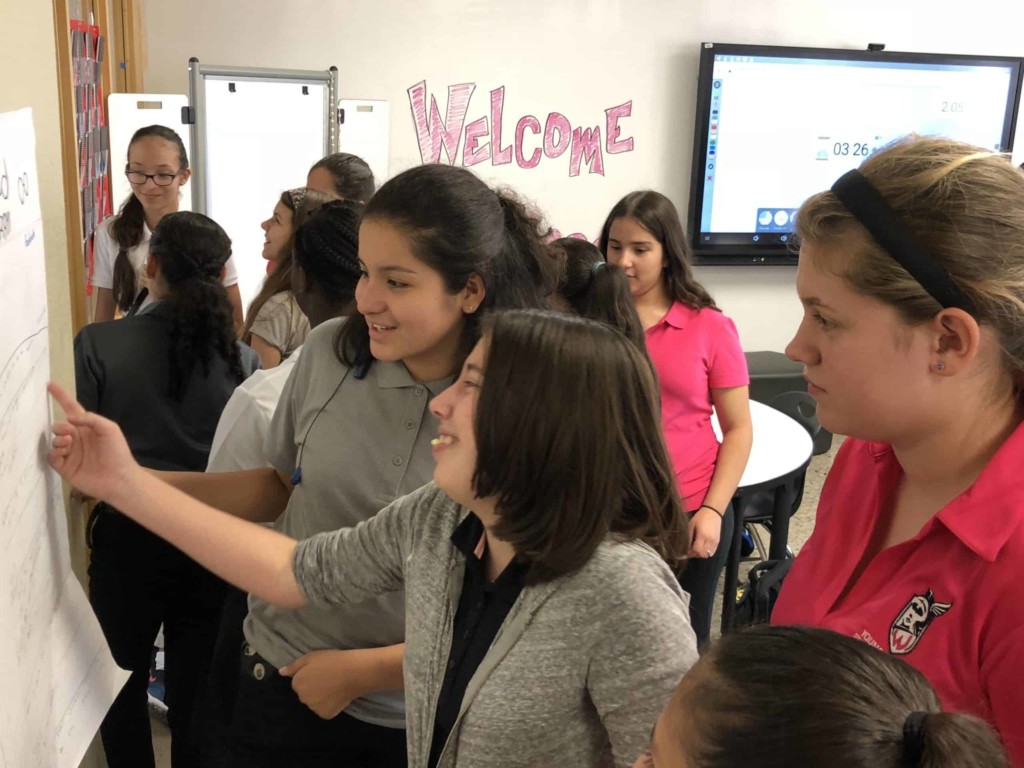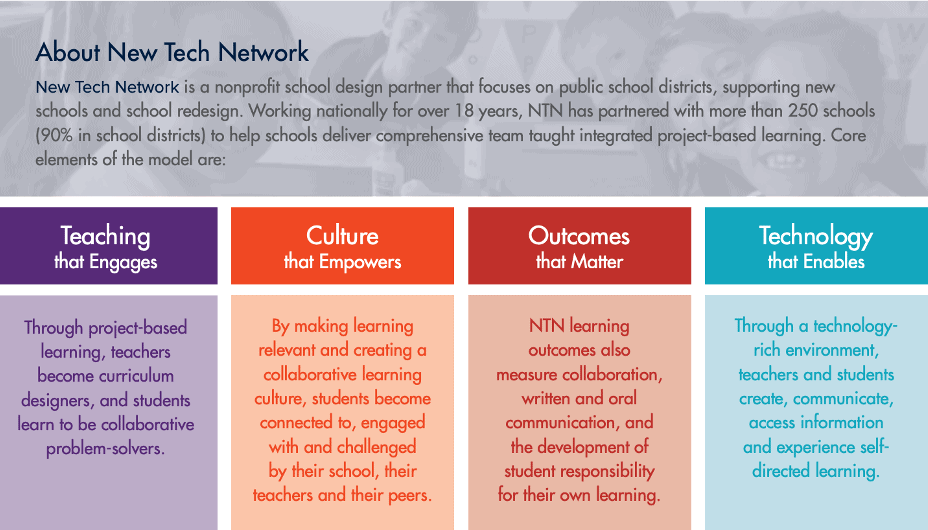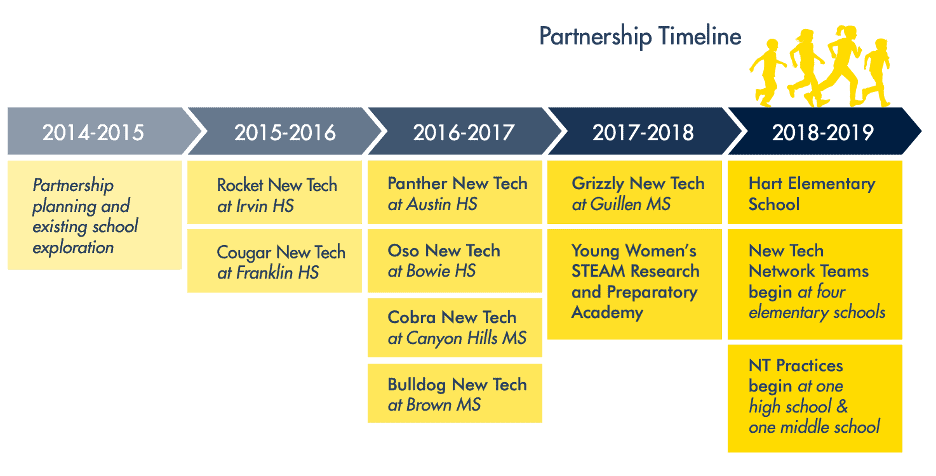How New Tech Schools Jumpstarted El Paso’s Education Transformation

Negotiating software contracts in 17 languages on three continents gave Juan Cabrera a pretty good sense of the relationship-building, problem-solving, and communication skills demanded by the innovation economy.
After taking on the leadership of El Paso Independent School District, Cabrera hosted town hall meetings with parents and staff members from all over the sprawling border city. Every meeting confirmed demand for innovation economy skills; creative thinkers, informed problem solvers, productive citizens, bilingual communicators, and socially and emotionally intelligent individuals.
In a district that had been focused on test preparation, the new El Paso leadership team needed a way to jumpstart new learning experiences and illustrate the path forward for both teachers and students.
“I wanted what all parents want for their children: school to support them academically, emotionally, socially and most of all, to prepare them for the world of today,” Cabrera said. “With that goal, we embarked on an ambitious strategy to become an active learning district.”
To move quickly, Cabrera knew he’d need to demonstrate to the community that his team could change how school functions with the same teachers, principals and buildings and achieve different and better results.
Cabrera had visited several high schools in the New Tech Network (NTN), and knew the team-taught integrated project-based approach produced the results they were looking for. New Tech Network has helped to create or transform more than 200 K-12 schools across the United States.
The four core principles shared by New Tech schools were well-suited to El Paso challenges:
- engaging teaching through project-based learning;
- creating an empowering collaborative learning culture;
- focusing on relevant metrics and student success outcomes; and
- and enabling a shift toward student agency through accessible technology.

Most learning in New Tech schools is conducted through team projects that take a couple of weeks or a month or two to complete. For each project, teachers assess oral and written communications, collaboration and agency on each project. NTN provides a rich repository of exemplary projects, along with teacher-designed projects from across all NTN schools. Teachers adapt and author projects on the ECHO learning platform. They benefit from school coaching and a variety of ongoing professional learning experiences.
El Paso developed plans to open six New Tech middle and high schools, each with a specific academic theme serving a diverse student population. In 2016, two academies on existing campuses opened: Rocket New Tech at Irvin High School and Cougar New Tech at Franklin High School.
A STEM-focused school, Rocket New Tech offers high school students a variety of pathways toward college and career. Students can sample courses in areas such as animal science and engineering but are required to take five years of math and science to obtain a STEM endorsement. Eleventh graders take part in a career prep course, which guides them through college and career preparation and opportunities including job shadowing with professionals in their fields of interest.
At Franklin Cougar New Tech, students have 42 dual-credit options in five magnet programs in engineering, legal studies, nursing via a partnership with Texas Tech, medical preceptorship, music production and engineering.
Following the two successful school-within-a-school demonstration projects, the district opened academies on four more campuses including Austin High School, Bowie High School, Canyon Mills Middle School and Brown Middle School. To avoid being positioned as only a turnaround model and to illustrate the benefits of active learning, New Tech academies were created in every neighborhood.
As more EPISD staff visited and worked with the New Tech model they witnessed dramatic changes in student engagement. The district began sharing active learning training and related infrastructure support with the other 80 schools. Educators said that due to the improved culture and teaching conditions, they felt more agency and ownership.
Inspiring Student Outcomes in the NTN Model
Early results in the first six New Tech Network schools were strong. Students demonstrated impressive growth in engagement, attendance, math and literacy achievement and workplace skills utilizing both NTN assessments and Texas STAAR tests.
In 2017, EPISD created two firsts. The only single-gender school in the NTN network, Young Women’s STEAM Research & Preparatory Academy, opened with plans to become a 6-12 school (see featured image). Hart Elementary and Guillen Middle School joined Oso New Tech at Bowie High to become the first bilingual K-12 feeder pattern in the New Tech Network.
Pressure Testing the Change Model
El Paso has become a national model for district transformation. Key elements of the change model include:
- Learner-focused community-connected plan with a graduate profile;
- Using new school development to quickly create high-quality options and to illustrate the path forward;
- Phasing in new technology-supported active learning models with infrastructure and professional learning; and
- Distributing and developing leadership and building an agile, can-do culture.
EPISD learned from the best districts in the country and worked with best in class partners in new school development and teacher professional learning. Most important was recruiting and retaining talented, aligned, and collaborative school and district leadership.
Like the rest of the country, El Paso was put to the test by the pandemic. The El Paso change model resulted in a relatively smooth transition to remote learning. That was particularly true for learners in New Tech schools who continued to work on projects in groups, utilizing the ECHO platform as their home base for communication, resources and feedback and working collaboratively in groups using various platforms. They engaged with their teachers in ways similar to the classroom experience.
The district will resume remote learning on August 17 and they’ll go back to campus September 8 conditions permitting. The combination of new and transformed schools in El Paso are agile and adaptable and ready for what the future holds.
For more, see:
- Back to School in El Paso: District and New Tech Expand Partnership
- El Paso and New Tech Network: District Transformation in High Gear
- El Paso Adopts Active Learning with Plan That Powers Innovation
Stay in-the-know with innovations in learning by signing up for the weekly Smart Update.
This post includes mentions of a Getting Smart partner. For a full list of partners, affiliate organizations and all other disclosures please see our Partner page.







0 Comments
Leave a Comment
Your email address will not be published. All fields are required.